Strategic Information System Report: ERP for University of Melbourne
VerifiedAdded on 2019/11/20
|17
|4027
|165
Report
AI Summary
This report analyzes the implementation of Strategic Information Systems (SIS) and Enterprise Resource Planning (ERP) systems, specifically focusing on their application within the University of Melbourne. The report begins by outlining the business processes involved, emphasizing the benefits of ERP in higher education, such as improved information management, transparency, and student satisfaction. It then delves into the business and system requirements for ERP implementation, including modular design, database integration, and scalability. The report also examines software and vendor selection, highlighting leading ERP vendors like Oracle, SAP, and PeopleSoft. Furthermore, it explores the utilization of technology to improve business efficiency, the evaluation of technology implementation, and potential security risks and data breaches. The report concludes with a discussion on risk mitigation strategies, providing a comprehensive overview of the considerations and challenges associated with implementing an SIS/ERP system in a university setting.
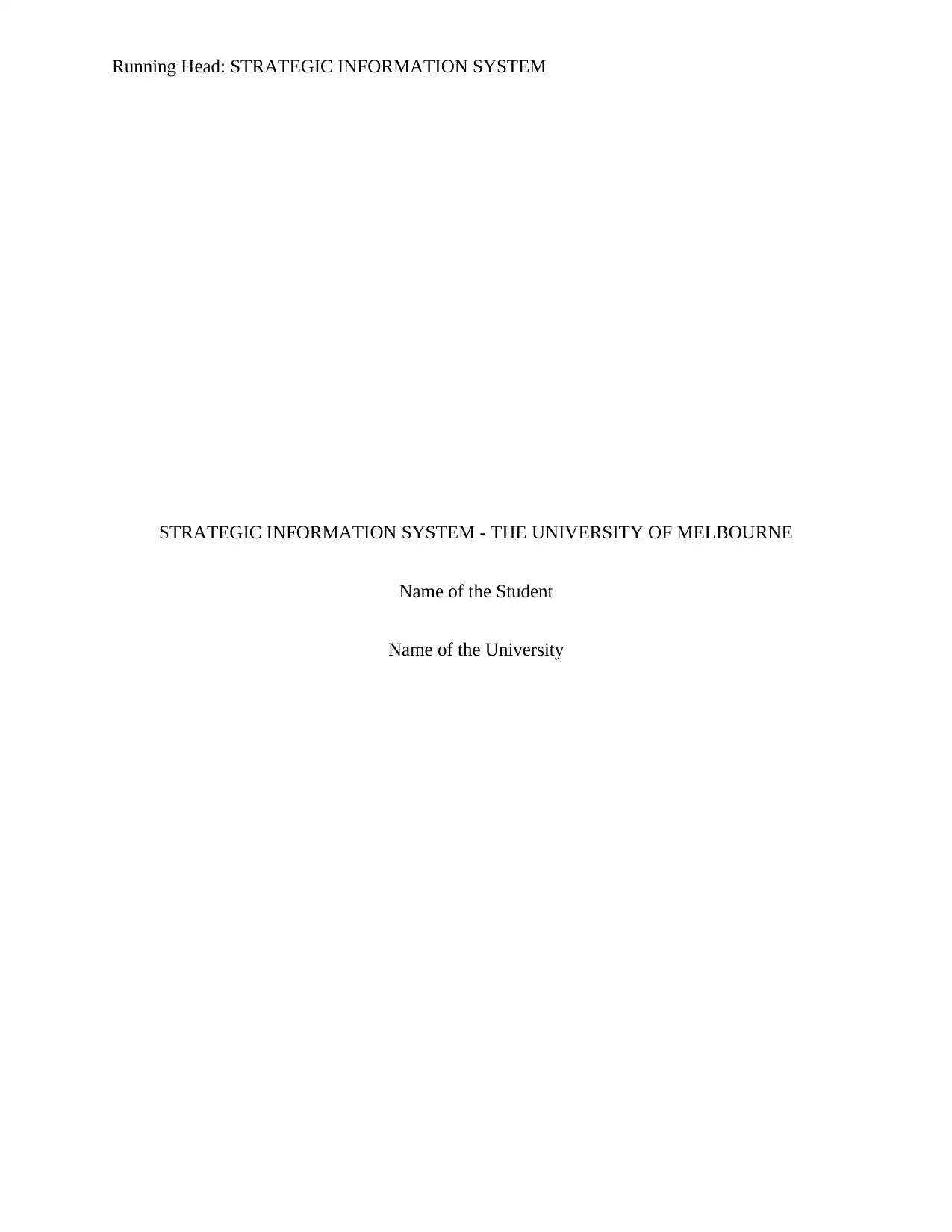
Running Head: STRATEGIC INFORMATION SYSTEM
STRATEGIC INFORMATION SYSTEM - THE UNIVERSITY OF MELBOURNE
Name of the Student
Name of the University
STRATEGIC INFORMATION SYSTEM - THE UNIVERSITY OF MELBOURNE
Name of the Student
Name of the University
Paraphrase This Document
Need a fresh take? Get an instant paraphrase of this document with our AI Paraphraser
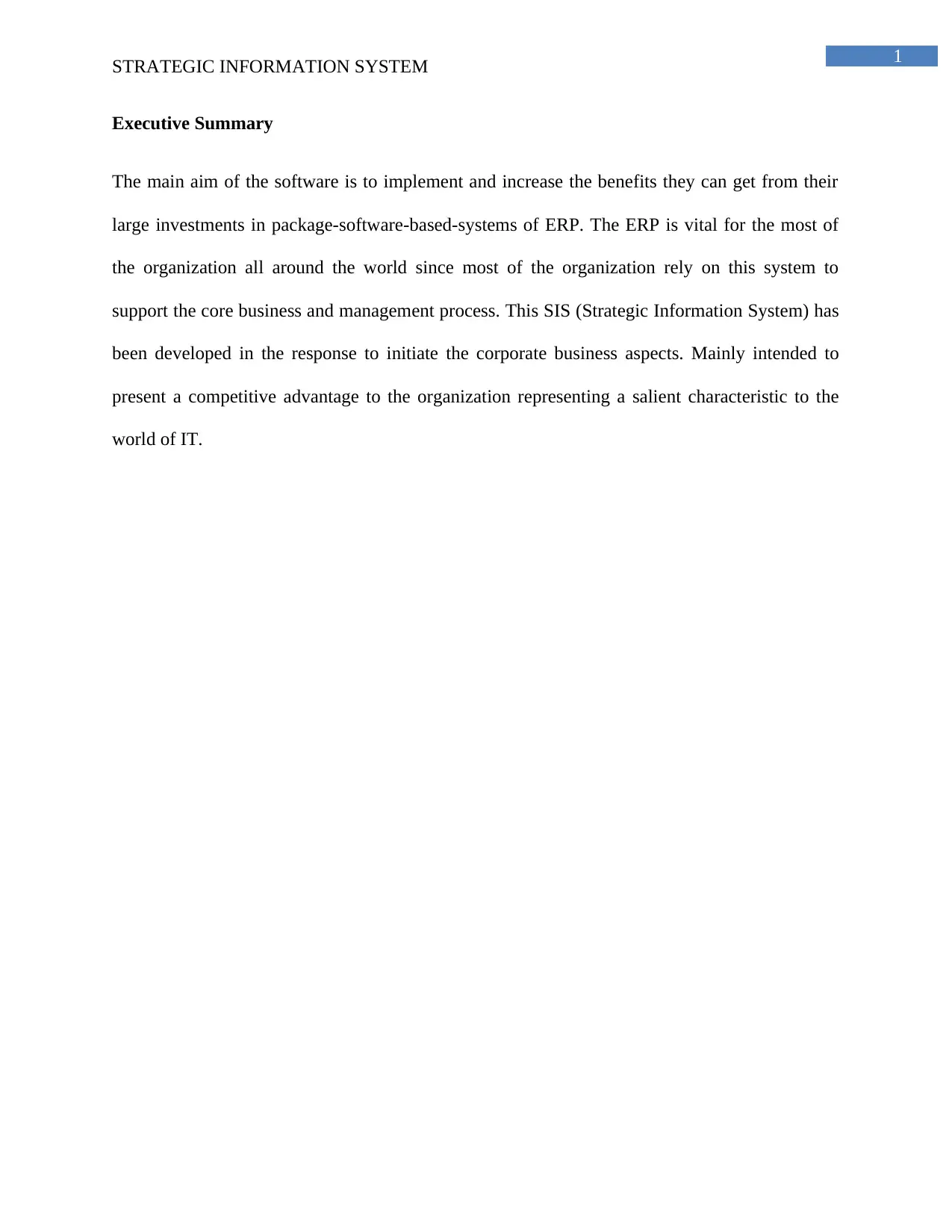
1
STRATEGIC INFORMATION SYSTEM
Executive Summary
The main aim of the software is to implement and increase the benefits they can get from their
large investments in package-software-based-systems of ERP. The ERP is vital for the most of
the organization all around the world since most of the organization rely on this system to
support the core business and management process. This SIS (Strategic Information System) has
been developed in the response to initiate the corporate business aspects. Mainly intended to
present a competitive advantage to the organization representing a salient characteristic to the
world of IT.
STRATEGIC INFORMATION SYSTEM
Executive Summary
The main aim of the software is to implement and increase the benefits they can get from their
large investments in package-software-based-systems of ERP. The ERP is vital for the most of
the organization all around the world since most of the organization rely on this system to
support the core business and management process. This SIS (Strategic Information System) has
been developed in the response to initiate the corporate business aspects. Mainly intended to
present a competitive advantage to the organization representing a salient characteristic to the
world of IT.
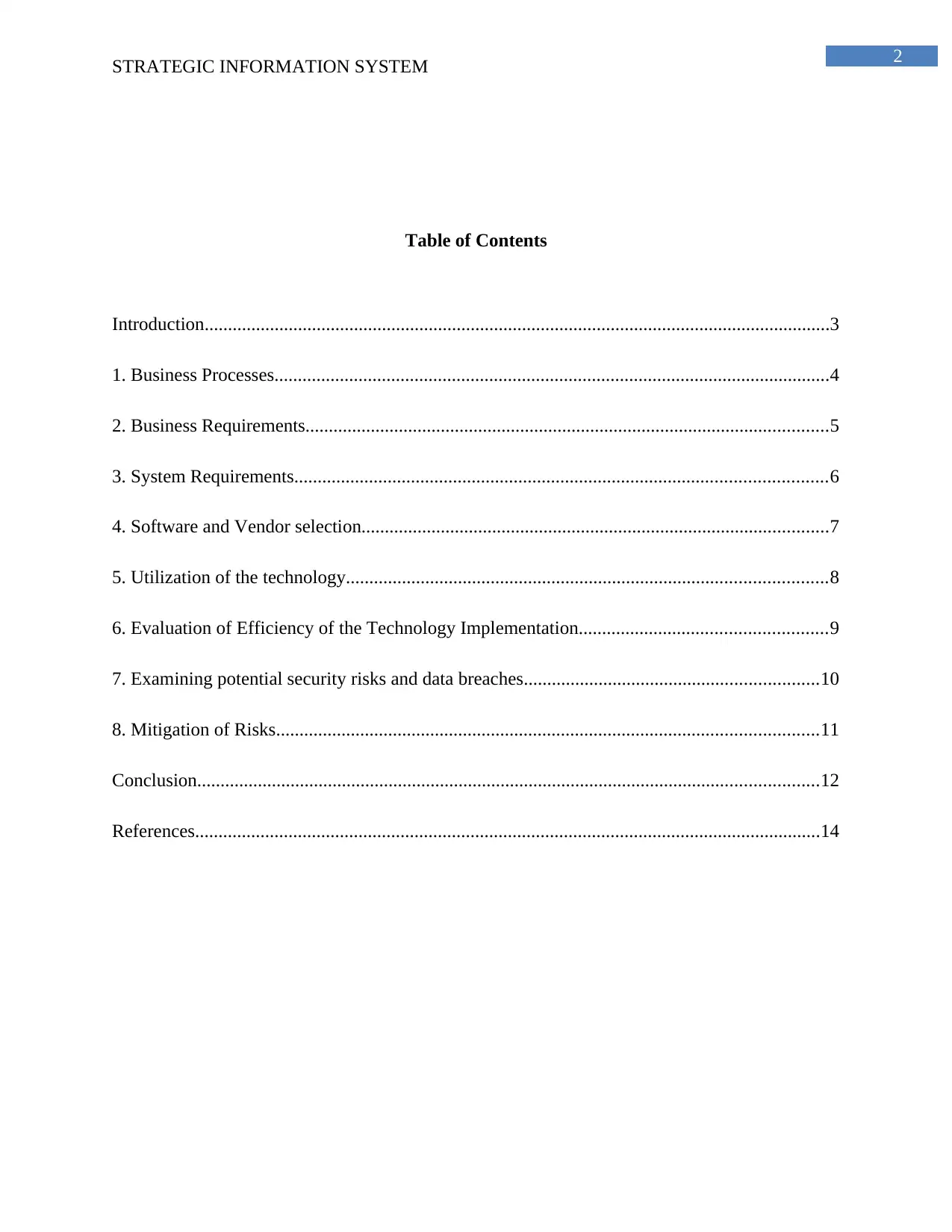
2
STRATEGIC INFORMATION SYSTEM
Table of Contents
Introduction......................................................................................................................................3
1. Business Processes.......................................................................................................................4
2. Business Requirements................................................................................................................5
3. System Requirements..................................................................................................................6
4. Software and Vendor selection....................................................................................................7
5. Utilization of the technology.......................................................................................................8
6. Evaluation of Efficiency of the Technology Implementation.....................................................9
7. Examining potential security risks and data breaches...............................................................10
8. Mitigation of Risks....................................................................................................................11
Conclusion.....................................................................................................................................12
References......................................................................................................................................14
STRATEGIC INFORMATION SYSTEM
Table of Contents
Introduction......................................................................................................................................3
1. Business Processes.......................................................................................................................4
2. Business Requirements................................................................................................................5
3. System Requirements..................................................................................................................6
4. Software and Vendor selection....................................................................................................7
5. Utilization of the technology.......................................................................................................8
6. Evaluation of Efficiency of the Technology Implementation.....................................................9
7. Examining potential security risks and data breaches...............................................................10
8. Mitigation of Risks....................................................................................................................11
Conclusion.....................................................................................................................................12
References......................................................................................................................................14
⊘ This is a preview!⊘
Do you want full access?
Subscribe today to unlock all pages.

Trusted by 1+ million students worldwide
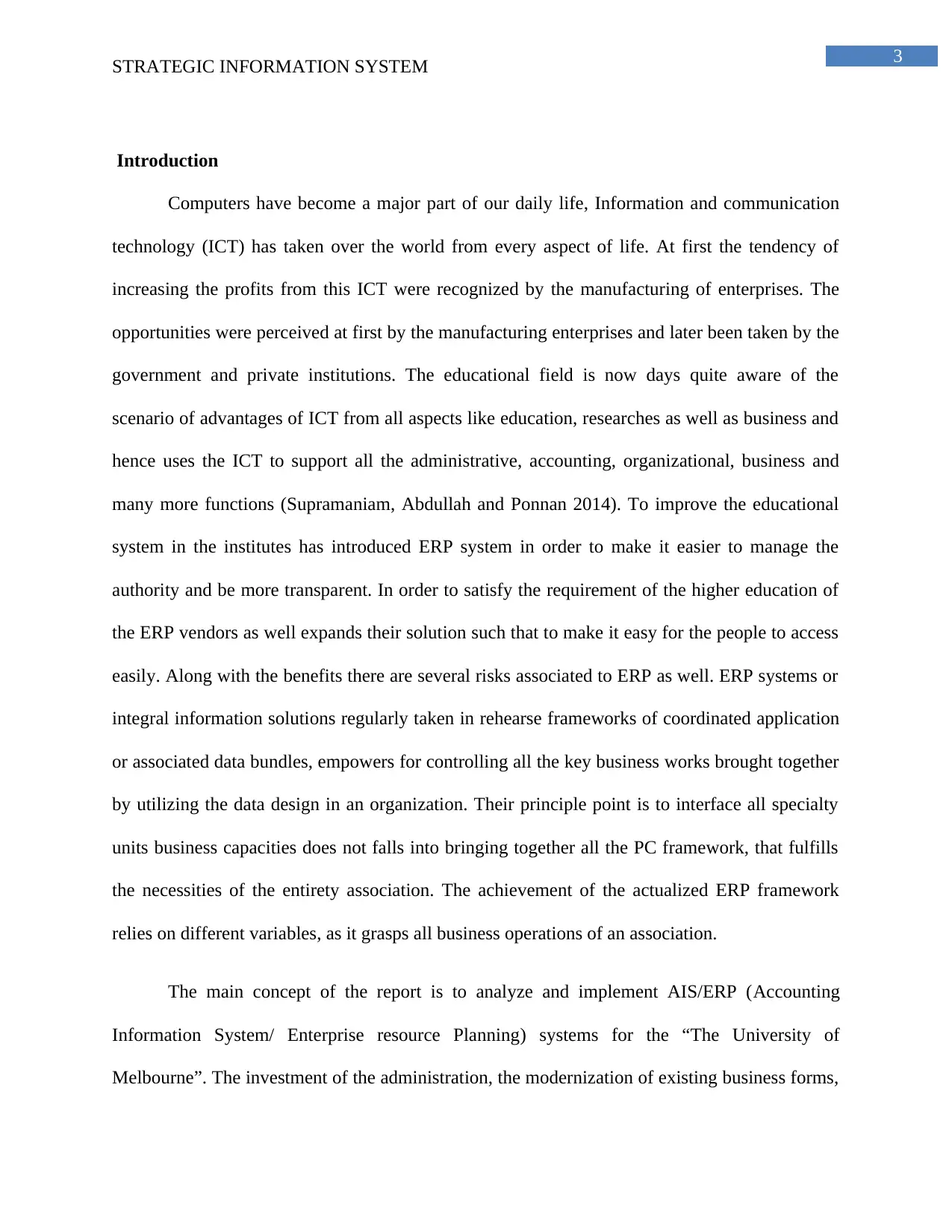
3
STRATEGIC INFORMATION SYSTEM
Introduction
Computers have become a major part of our daily life, Information and communication
technology (ICT) has taken over the world from every aspect of life. At first the tendency of
increasing the profits from this ICT were recognized by the manufacturing of enterprises. The
opportunities were perceived at first by the manufacturing enterprises and later been taken by the
government and private institutions. The educational field is now days quite aware of the
scenario of advantages of ICT from all aspects like education, researches as well as business and
hence uses the ICT to support all the administrative, accounting, organizational, business and
many more functions (Supramaniam, Abdullah and Ponnan 2014). To improve the educational
system in the institutes has introduced ERP system in order to make it easier to manage the
authority and be more transparent. In order to satisfy the requirement of the higher education of
the ERP vendors as well expands their solution such that to make it easy for the people to access
easily. Along with the benefits there are several risks associated to ERP as well. ERP systems or
integral information solutions regularly taken in rehearse frameworks of coordinated application
or associated data bundles, empowers for controlling all the key business works brought together
by utilizing the data design in an organization. Their principle point is to interface all specialty
units business capacities does not falls into bringing together all the PC framework, that fulfills
the necessities of the entirety association. The achievement of the actualized ERP framework
relies on different variables, as it grasps all business operations of an association.
The main concept of the report is to analyze and implement AIS/ERP (Accounting
Information System/ Enterprise resource Planning) systems for the “The University of
Melbourne”. The investment of the administration, the modernization of existing business forms,
STRATEGIC INFORMATION SYSTEM
Introduction
Computers have become a major part of our daily life, Information and communication
technology (ICT) has taken over the world from every aspect of life. At first the tendency of
increasing the profits from this ICT were recognized by the manufacturing of enterprises. The
opportunities were perceived at first by the manufacturing enterprises and later been taken by the
government and private institutions. The educational field is now days quite aware of the
scenario of advantages of ICT from all aspects like education, researches as well as business and
hence uses the ICT to support all the administrative, accounting, organizational, business and
many more functions (Supramaniam, Abdullah and Ponnan 2014). To improve the educational
system in the institutes has introduced ERP system in order to make it easier to manage the
authority and be more transparent. In order to satisfy the requirement of the higher education of
the ERP vendors as well expands their solution such that to make it easy for the people to access
easily. Along with the benefits there are several risks associated to ERP as well. ERP systems or
integral information solutions regularly taken in rehearse frameworks of coordinated application
or associated data bundles, empowers for controlling all the key business works brought together
by utilizing the data design in an organization. Their principle point is to interface all specialty
units business capacities does not falls into bringing together all the PC framework, that fulfills
the necessities of the entirety association. The achievement of the actualized ERP framework
relies on different variables, as it grasps all business operations of an association.
The main concept of the report is to analyze and implement AIS/ERP (Accounting
Information System/ Enterprise resource Planning) systems for the “The University of
Melbourne”. The investment of the administration, the modernization of existing business forms,
Paraphrase This Document
Need a fresh take? Get an instant paraphrase of this document with our AI Paraphraser
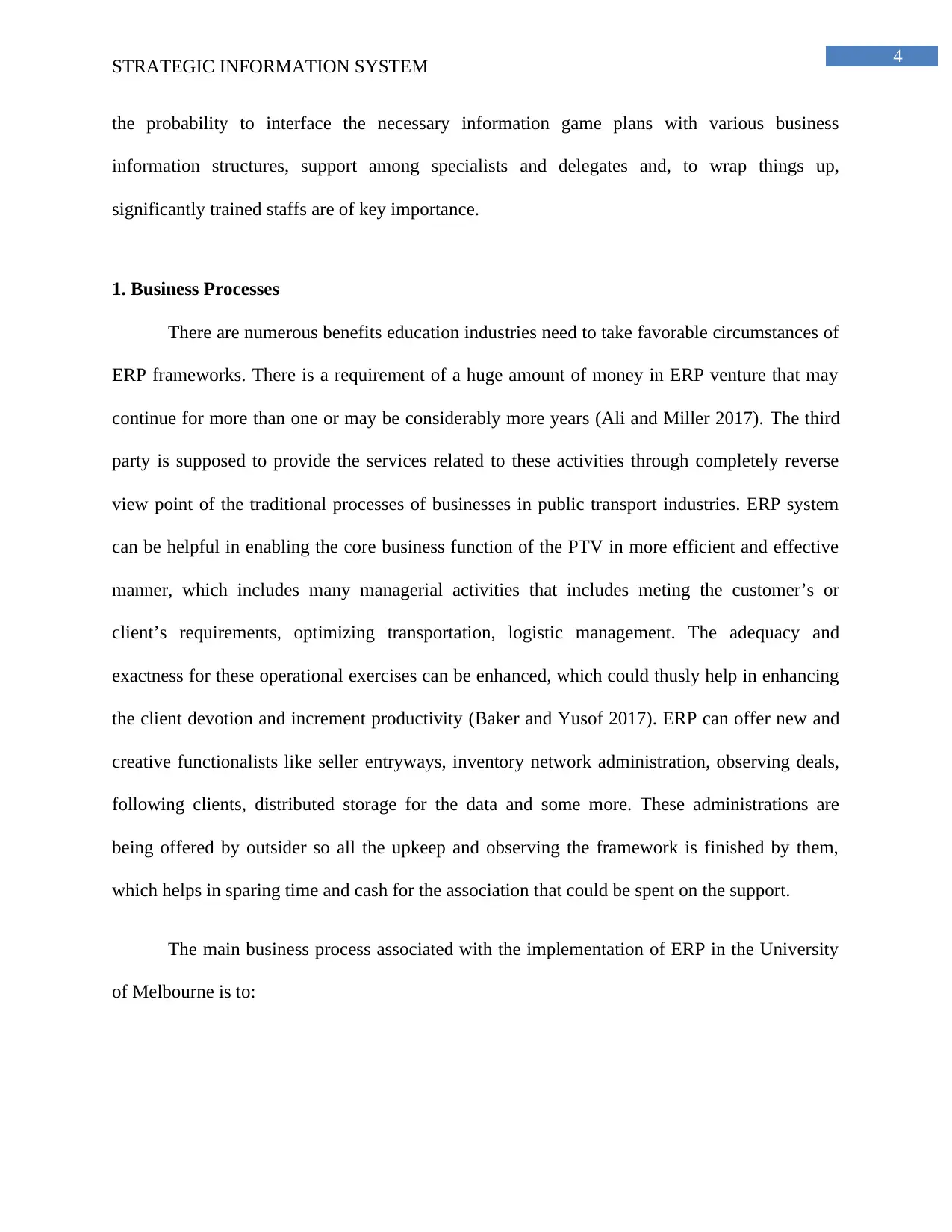
4
STRATEGIC INFORMATION SYSTEM
the probability to interface the necessary information game plans with various business
information structures, support among specialists and delegates and, to wrap things up,
significantly trained staffs are of key importance.
1. Business Processes
There are numerous benefits education industries need to take favorable circumstances of
ERP frameworks. There is a requirement of a huge amount of money in ERP venture that may
continue for more than one or may be considerably more years (Ali and Miller 2017). The third
party is supposed to provide the services related to these activities through completely reverse
view point of the traditional processes of businesses in public transport industries. ERP system
can be helpful in enabling the core business function of the PTV in more efficient and effective
manner, which includes many managerial activities that includes meting the customer’s or
client’s requirements, optimizing transportation, logistic management. The adequacy and
exactness for these operational exercises can be enhanced, which could thusly help in enhancing
the client devotion and increment productivity (Baker and Yusof 2017). ERP can offer new and
creative functionalists like seller entryways, inventory network administration, observing deals,
following clients, distributed storage for the data and some more. These administrations are
being offered by outsider so all the upkeep and observing the framework is finished by them,
which helps in sparing time and cash for the association that could be spent on the support.
The main business process associated with the implementation of ERP in the University
of Melbourne is to:
STRATEGIC INFORMATION SYSTEM
the probability to interface the necessary information game plans with various business
information structures, support among specialists and delegates and, to wrap things up,
significantly trained staffs are of key importance.
1. Business Processes
There are numerous benefits education industries need to take favorable circumstances of
ERP frameworks. There is a requirement of a huge amount of money in ERP venture that may
continue for more than one or may be considerably more years (Ali and Miller 2017). The third
party is supposed to provide the services related to these activities through completely reverse
view point of the traditional processes of businesses in public transport industries. ERP system
can be helpful in enabling the core business function of the PTV in more efficient and effective
manner, which includes many managerial activities that includes meting the customer’s or
client’s requirements, optimizing transportation, logistic management. The adequacy and
exactness for these operational exercises can be enhanced, which could thusly help in enhancing
the client devotion and increment productivity (Baker and Yusof 2017). ERP can offer new and
creative functionalists like seller entryways, inventory network administration, observing deals,
following clients, distributed storage for the data and some more. These administrations are
being offered by outsider so all the upkeep and observing the framework is finished by them,
which helps in sparing time and cash for the association that could be spent on the support.
The main business process associated with the implementation of ERP in the University
of Melbourne is to:
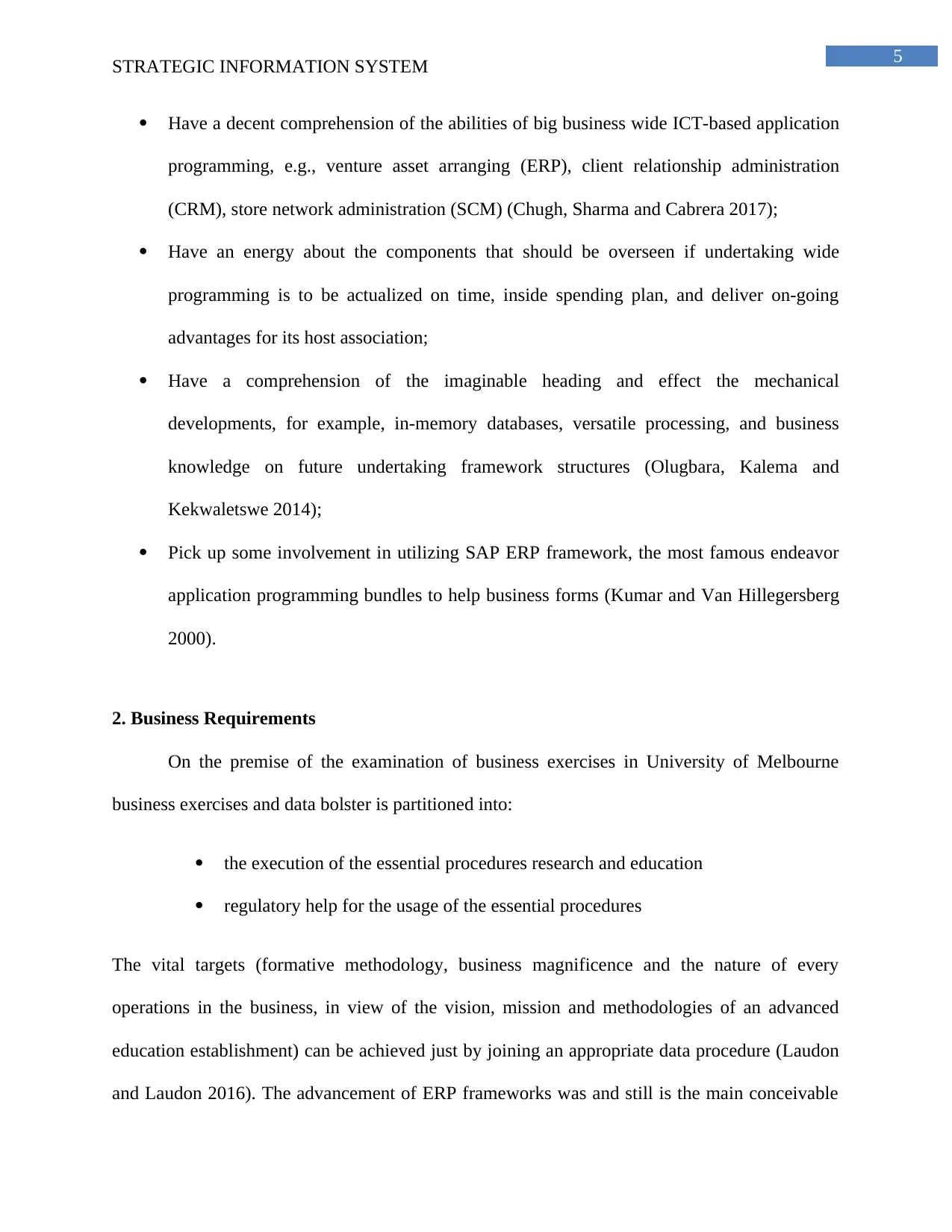
5
STRATEGIC INFORMATION SYSTEM
Have a decent comprehension of the abilities of big business wide ICT-based application
programming, e.g., venture asset arranging (ERP), client relationship administration
(CRM), store network administration (SCM) (Chugh, Sharma and Cabrera 2017);
Have an energy about the components that should be overseen if undertaking wide
programming is to be actualized on time, inside spending plan, and deliver on-going
advantages for its host association;
Have a comprehension of the imaginable heading and effect the mechanical
developments, for example, in-memory databases, versatile processing, and business
knowledge on future undertaking framework structures (Olugbara, Kalema and
Kekwaletswe 2014);
Pick up some involvement in utilizing SAP ERP framework, the most famous endeavor
application programming bundles to help business forms (Kumar and Van Hillegersberg
2000).
2. Business Requirements
On the premise of the examination of business exercises in University of Melbourne
business exercises and data bolster is partitioned into:
the execution of the essential procedures research and education
regulatory help for the usage of the essential procedures
The vital targets (formative methodology, business magnificence and the nature of every
operations in the business, in view of the vision, mission and methodologies of an advanced
education establishment) can be achieved just by joining an appropriate data procedure (Laudon
and Laudon 2016). The advancement of ERP frameworks was and still is the main conceivable
STRATEGIC INFORMATION SYSTEM
Have a decent comprehension of the abilities of big business wide ICT-based application
programming, e.g., venture asset arranging (ERP), client relationship administration
(CRM), store network administration (SCM) (Chugh, Sharma and Cabrera 2017);
Have an energy about the components that should be overseen if undertaking wide
programming is to be actualized on time, inside spending plan, and deliver on-going
advantages for its host association;
Have a comprehension of the imaginable heading and effect the mechanical
developments, for example, in-memory databases, versatile processing, and business
knowledge on future undertaking framework structures (Olugbara, Kalema and
Kekwaletswe 2014);
Pick up some involvement in utilizing SAP ERP framework, the most famous endeavor
application programming bundles to help business forms (Kumar and Van Hillegersberg
2000).
2. Business Requirements
On the premise of the examination of business exercises in University of Melbourne
business exercises and data bolster is partitioned into:
the execution of the essential procedures research and education
regulatory help for the usage of the essential procedures
The vital targets (formative methodology, business magnificence and the nature of every
operations in the business, in view of the vision, mission and methodologies of an advanced
education establishment) can be achieved just by joining an appropriate data procedure (Laudon
and Laudon 2016). The advancement of ERP frameworks was and still is the main conceivable
⊘ This is a preview!⊘
Do you want full access?
Subscribe today to unlock all pages.

Trusted by 1+ million students worldwide

6
STRATEGIC INFORMATION SYSTEM
path for achieving these objectives, since it includes the usual views on the operations of
business and a database commonly used for the data transaction.
3. System Requirements
An ERP framework is required to have the accompanying attributes:
Modular plan containing a huge business modules like, money related, producing,
bookkeeping, conveyance, and so on.
Use incorporated regular database administration framework (DBMS)
The modules have been coordinated and have to give consistent data stream to the
module, expanding the operation straight forwardness through the standard
interface.
Large and complex framework by including high cost.
Adaptable and usable and offers best business rehearses.
They require tedious fitting and design setups for incorporating with the
organization's business capacities (Supramaniam, Abdullah and Ponnan 2014)
The modules work progressively with on the web and clump handling capacities
They are or soon they will be Internet-empowered
The base framework necessities to introduce SAP ERP ought to be known before you
choose to introduce it. A few least equipment and programming prerequisites are basic and must
be investigated in order to introduce SAP ERP (Nwankpa 2015). Since SAP is customer server
design programming, the application will run on the server and thus the customers will associate
with this server. A UI should be introduced to the client’s end that might be a desktop, some
STRATEGIC INFORMATION SYSTEM
path for achieving these objectives, since it includes the usual views on the operations of
business and a database commonly used for the data transaction.
3. System Requirements
An ERP framework is required to have the accompanying attributes:
Modular plan containing a huge business modules like, money related, producing,
bookkeeping, conveyance, and so on.
Use incorporated regular database administration framework (DBMS)
The modules have been coordinated and have to give consistent data stream to the
module, expanding the operation straight forwardness through the standard
interface.
Large and complex framework by including high cost.
Adaptable and usable and offers best business rehearses.
They require tedious fitting and design setups for incorporating with the
organization's business capacities (Supramaniam, Abdullah and Ponnan 2014)
The modules work progressively with on the web and clump handling capacities
They are or soon they will be Internet-empowered
The base framework necessities to introduce SAP ERP ought to be known before you
choose to introduce it. A few least equipment and programming prerequisites are basic and must
be investigated in order to introduce SAP ERP (Nwankpa 2015). Since SAP is customer server
design programming, the application will run on the server and thus the customers will associate
with this server. A UI should be introduced to the client’s end that might be a desktop, some
Paraphrase This Document
Need a fresh take? Get an instant paraphrase of this document with our AI Paraphraser

7
STRATEGIC INFORMATION SYSTEM
gadgets or portable workstation. Quality customers who are ought to be running in the servers
will choose the limit of the server (Qian, Schmidt and Scott 2015).
4. Software and Vendor selection
The primary ERP Vendors for advanced education on the planet are Oracle, SCT,
PeopleSoft, SAP, Jenzabar and Datatel. In spite of the current year's merger amongst PeopleSoft
and Oracle Corporation, the last will keep the advancement bureau of PeopleSoft and their items,
in this way these two organizations will be managed (Wibowo et al. 2016). As per explore
completed by an association it can be seen that none of these sellers is a market pioneer.
Arrangements of these organizations grasp the dominant part of fundamental elements of ERP
frameworks (overseeing study process, overseeing human assets and fund). Favorable
circumstances of person arrangements can be seen in various zones. PeopleSoft underline the
part of Internet and web advances (achieving virtual association through entryways), SAP is
supportive of ERP frameworks focused on clients (understudy part which is understudy
arranged, and so forth.), Oracle associated the Web and back-office operations in E-Business
bundle (Zschieck, Weiss and Wirz 2016).
Distinctive ERP sellers furnish ERP frameworks with a few level of strengths yet the
center modules are thus practically the same for every one of them (Shaul and Tauber 2013). A
portion of the center ERP modules found in the effective ERP frameworks are the
accompanying:
Financial management
Accounting management
Production management
STRATEGIC INFORMATION SYSTEM
gadgets or portable workstation. Quality customers who are ought to be running in the servers
will choose the limit of the server (Qian, Schmidt and Scott 2015).
4. Software and Vendor selection
The primary ERP Vendors for advanced education on the planet are Oracle, SCT,
PeopleSoft, SAP, Jenzabar and Datatel. In spite of the current year's merger amongst PeopleSoft
and Oracle Corporation, the last will keep the advancement bureau of PeopleSoft and their items,
in this way these two organizations will be managed (Wibowo et al. 2016). As per explore
completed by an association it can be seen that none of these sellers is a market pioneer.
Arrangements of these organizations grasp the dominant part of fundamental elements of ERP
frameworks (overseeing study process, overseeing human assets and fund). Favorable
circumstances of person arrangements can be seen in various zones. PeopleSoft underline the
part of Internet and web advances (achieving virtual association through entryways), SAP is
supportive of ERP frameworks focused on clients (understudy part which is understudy
arranged, and so forth.), Oracle associated the Web and back-office operations in E-Business
bundle (Zschieck, Weiss and Wirz 2016).
Distinctive ERP sellers furnish ERP frameworks with a few level of strengths yet the
center modules are thus practically the same for every one of them (Shaul and Tauber 2013). A
portion of the center ERP modules found in the effective ERP frameworks are the
accompanying:
Financial management
Accounting management
Production management
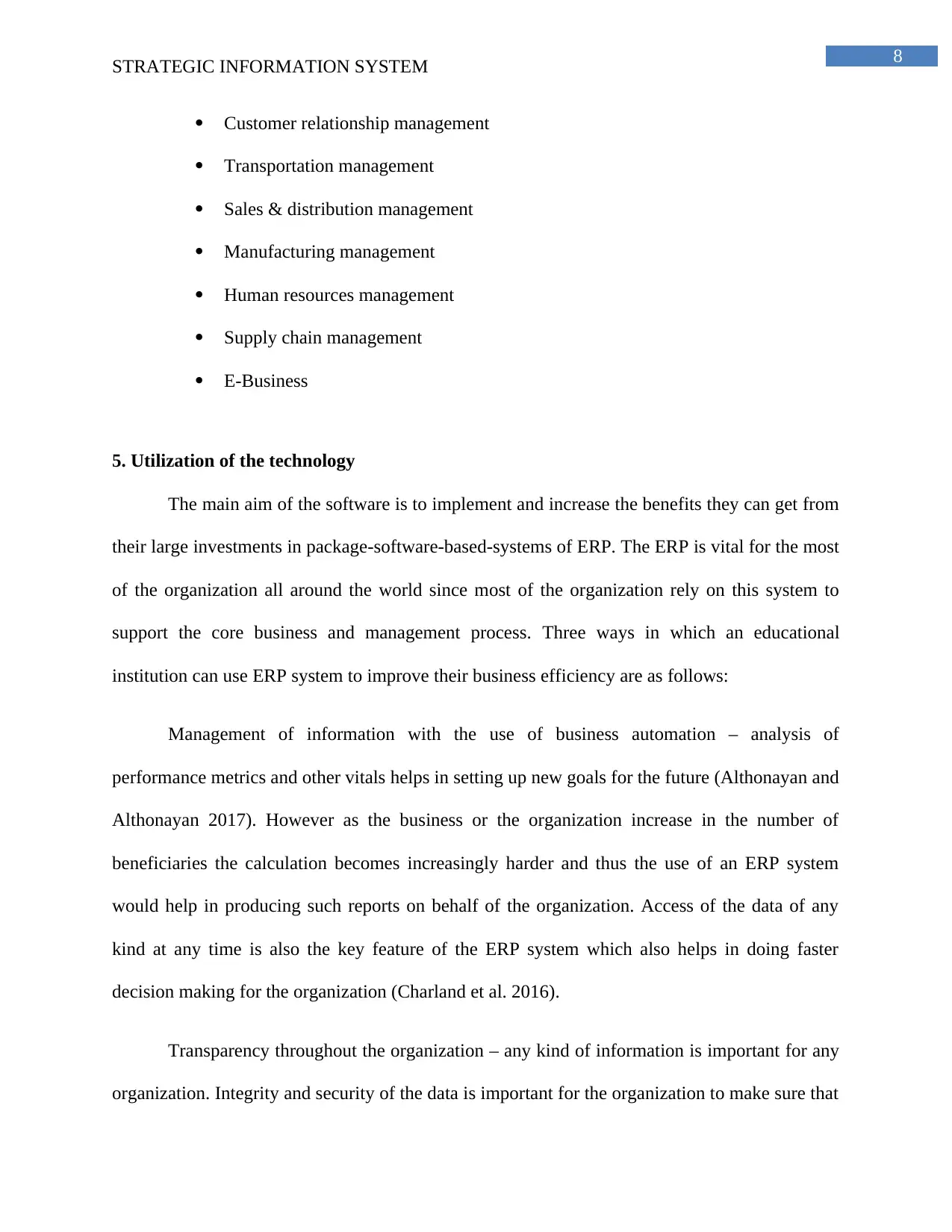
8
STRATEGIC INFORMATION SYSTEM
Customer relationship management
Transportation management
Sales & distribution management
Manufacturing management
Human resources management
Supply chain management
E-Business
5. Utilization of the technology
The main aim of the software is to implement and increase the benefits they can get from
their large investments in package-software-based-systems of ERP. The ERP is vital for the most
of the organization all around the world since most of the organization rely on this system to
support the core business and management process. Three ways in which an educational
institution can use ERP system to improve their business efficiency are as follows:
Management of information with the use of business automation – analysis of
performance metrics and other vitals helps in setting up new goals for the future (Althonayan and
Althonayan 2017). However as the business or the organization increase in the number of
beneficiaries the calculation becomes increasingly harder and thus the use of an ERP system
would help in producing such reports on behalf of the organization. Access of the data of any
kind at any time is also the key feature of the ERP system which also helps in doing faster
decision making for the organization (Charland et al. 2016).
Transparency throughout the organization – any kind of information is important for any
organization. Integrity and security of the data is important for the organization to make sure that
STRATEGIC INFORMATION SYSTEM
Customer relationship management
Transportation management
Sales & distribution management
Manufacturing management
Human resources management
Supply chain management
E-Business
5. Utilization of the technology
The main aim of the software is to implement and increase the benefits they can get from
their large investments in package-software-based-systems of ERP. The ERP is vital for the most
of the organization all around the world since most of the organization rely on this system to
support the core business and management process. Three ways in which an educational
institution can use ERP system to improve their business efficiency are as follows:
Management of information with the use of business automation – analysis of
performance metrics and other vitals helps in setting up new goals for the future (Althonayan and
Althonayan 2017). However as the business or the organization increase in the number of
beneficiaries the calculation becomes increasingly harder and thus the use of an ERP system
would help in producing such reports on behalf of the organization. Access of the data of any
kind at any time is also the key feature of the ERP system which also helps in doing faster
decision making for the organization (Charland et al. 2016).
Transparency throughout the organization – any kind of information is important for any
organization. Integrity and security of the data is important for the organization to make sure that
⊘ This is a preview!⊘
Do you want full access?
Subscribe today to unlock all pages.

Trusted by 1+ million students worldwide

9
STRATEGIC INFORMATION SYSTEM
the information can be processed and accessed by the authorized person (Fryling 2015). The
information storage should be done in a single place and the updating of the data should be done
from multiple places. After following such rules and procedures it is important that the integrity
and security of the data is still in place (Kurbel 2013). Thus the use of a role based ERP system
helps in the use of the system in a transparent manner as well as keeping it secure.
High achievement of customer satisfaction –the end product of providing any kind of
service is the satisfaction of the customer (Noaman and Ahmed 2015). Keeping in track of the
warehouse data and stocks help in the smooth production of the report at the end of the working.
The system will be holding information related to all the students in the university. ERP
software thus helps an educational institution to keep track of the students who has not yet paid
their fees and subsequent working of the procedure. This will help the institution to manage the
users and the student smoothly and deal with the efficiency of the ERP system (Olugbara,
Kalema and Kekwaletswe 2014).
6. Evaluation of Efficiency of the Technology Implementation
To improve the educational system the institutes has introduced ERP system in order to
make it easier to manage the authority and be more transparent. In order to satisfy the
requirement of the higher education of the ERP vendors as well expands their solution such that
to make it easy for the people to access easily, role based ERP system helps in the use of the
system in a transparent manner. Along with the benefits there are several risks associated to ERP
as well. ERP systems or integral information solutions regularly taken in rehearse frameworks of
associated data or coordinated application bundles, empowers to control all key business works
in an organization by utilizing brought together data design.
STRATEGIC INFORMATION SYSTEM
the information can be processed and accessed by the authorized person (Fryling 2015). The
information storage should be done in a single place and the updating of the data should be done
from multiple places. After following such rules and procedures it is important that the integrity
and security of the data is still in place (Kurbel 2013). Thus the use of a role based ERP system
helps in the use of the system in a transparent manner as well as keeping it secure.
High achievement of customer satisfaction –the end product of providing any kind of
service is the satisfaction of the customer (Noaman and Ahmed 2015). Keeping in track of the
warehouse data and stocks help in the smooth production of the report at the end of the working.
The system will be holding information related to all the students in the university. ERP
software thus helps an educational institution to keep track of the students who has not yet paid
their fees and subsequent working of the procedure. This will help the institution to manage the
users and the student smoothly and deal with the efficiency of the ERP system (Olugbara,
Kalema and Kekwaletswe 2014).
6. Evaluation of Efficiency of the Technology Implementation
To improve the educational system the institutes has introduced ERP system in order to
make it easier to manage the authority and be more transparent. In order to satisfy the
requirement of the higher education of the ERP vendors as well expands their solution such that
to make it easy for the people to access easily, role based ERP system helps in the use of the
system in a transparent manner. Along with the benefits there are several risks associated to ERP
as well. ERP systems or integral information solutions regularly taken in rehearse frameworks of
associated data or coordinated application bundles, empowers to control all key business works
in an organization by utilizing brought together data design.
Paraphrase This Document
Need a fresh take? Get an instant paraphrase of this document with our AI Paraphraser

10
STRATEGIC INFORMATION SYSTEM
The ERP system implementation in an educational institution can have the following
benefits:
Use of an educational ERP system helps the administrative staff to manage and
analyze all the necessary information and do all these work in real time (Zschieck,
Weiss and Wirz 2016).
They will be able to make accurate decisions and also update the time of their
updates.
The administrators will be able to assess the large amount of data that is available
for the use of the ERP system (Ram, Corkindale and Wu 2013).
Completion of any task digitally helps in saving a lot of time for the students as
well as the administrators.
ERP system helps in better communication between all the entities of the
educational institution
Tasks can be automated in the system which will save more time for the
employees which can be used to do other productive works.
Provision of self service facilities help students to get enrolled faster than before
and thus the institution can focus on the working of the educational system
(Tatnall 2015).
The new systems provide the use of a backup system which helps the organization
to take a soft copy of all the data of the company and also save them so that they
can act as a faster access for smaller works (Zschieck,Weiss and Wirz 2016).
STRATEGIC INFORMATION SYSTEM
The ERP system implementation in an educational institution can have the following
benefits:
Use of an educational ERP system helps the administrative staff to manage and
analyze all the necessary information and do all these work in real time (Zschieck,
Weiss and Wirz 2016).
They will be able to make accurate decisions and also update the time of their
updates.
The administrators will be able to assess the large amount of data that is available
for the use of the ERP system (Ram, Corkindale and Wu 2013).
Completion of any task digitally helps in saving a lot of time for the students as
well as the administrators.
ERP system helps in better communication between all the entities of the
educational institution
Tasks can be automated in the system which will save more time for the
employees which can be used to do other productive works.
Provision of self service facilities help students to get enrolled faster than before
and thus the institution can focus on the working of the educational system
(Tatnall 2015).
The new systems provide the use of a backup system which helps the organization
to take a soft copy of all the data of the company and also save them so that they
can act as a faster access for smaller works (Zschieck,Weiss and Wirz 2016).
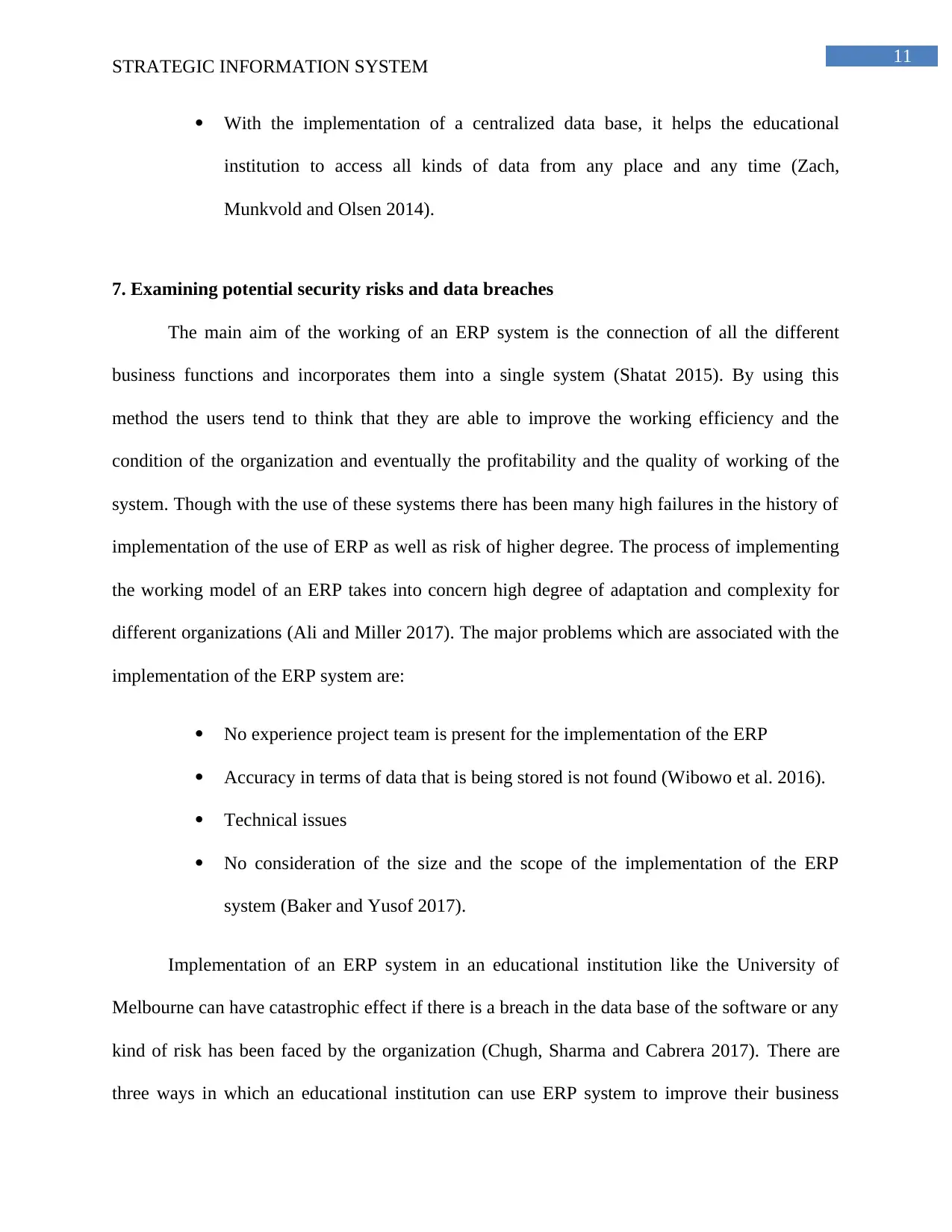
11
STRATEGIC INFORMATION SYSTEM
With the implementation of a centralized data base, it helps the educational
institution to access all kinds of data from any place and any time (Zach,
Munkvold and Olsen 2014).
7. Examining potential security risks and data breaches
The main aim of the working of an ERP system is the connection of all the different
business functions and incorporates them into a single system (Shatat 2015). By using this
method the users tend to think that they are able to improve the working efficiency and the
condition of the organization and eventually the profitability and the quality of working of the
system. Though with the use of these systems there has been many high failures in the history of
implementation of the use of ERP as well as risk of higher degree. The process of implementing
the working model of an ERP takes into concern high degree of adaptation and complexity for
different organizations (Ali and Miller 2017). The major problems which are associated with the
implementation of the ERP system are:
No experience project team is present for the implementation of the ERP
Accuracy in terms of data that is being stored is not found (Wibowo et al. 2016).
Technical issues
No consideration of the size and the scope of the implementation of the ERP
system (Baker and Yusof 2017).
Implementation of an ERP system in an educational institution like the University of
Melbourne can have catastrophic effect if there is a breach in the data base of the software or any
kind of risk has been faced by the organization (Chugh, Sharma and Cabrera 2017). There are
three ways in which an educational institution can use ERP system to improve their business
STRATEGIC INFORMATION SYSTEM
With the implementation of a centralized data base, it helps the educational
institution to access all kinds of data from any place and any time (Zach,
Munkvold and Olsen 2014).
7. Examining potential security risks and data breaches
The main aim of the working of an ERP system is the connection of all the different
business functions and incorporates them into a single system (Shatat 2015). By using this
method the users tend to think that they are able to improve the working efficiency and the
condition of the organization and eventually the profitability and the quality of working of the
system. Though with the use of these systems there has been many high failures in the history of
implementation of the use of ERP as well as risk of higher degree. The process of implementing
the working model of an ERP takes into concern high degree of adaptation and complexity for
different organizations (Ali and Miller 2017). The major problems which are associated with the
implementation of the ERP system are:
No experience project team is present for the implementation of the ERP
Accuracy in terms of data that is being stored is not found (Wibowo et al. 2016).
Technical issues
No consideration of the size and the scope of the implementation of the ERP
system (Baker and Yusof 2017).
Implementation of an ERP system in an educational institution like the University of
Melbourne can have catastrophic effect if there is a breach in the data base of the software or any
kind of risk has been faced by the organization (Chugh, Sharma and Cabrera 2017). There are
three ways in which an educational institution can use ERP system to improve their business
⊘ This is a preview!⊘
Do you want full access?
Subscribe today to unlock all pages.

Trusted by 1+ million students worldwide
1 out of 17
Related Documents
Your All-in-One AI-Powered Toolkit for Academic Success.
+13062052269
info@desklib.com
Available 24*7 on WhatsApp / Email
![[object Object]](/_next/static/media/star-bottom.7253800d.svg)
Unlock your academic potential
Copyright © 2020–2025 A2Z Services. All Rights Reserved. Developed and managed by ZUCOL.





